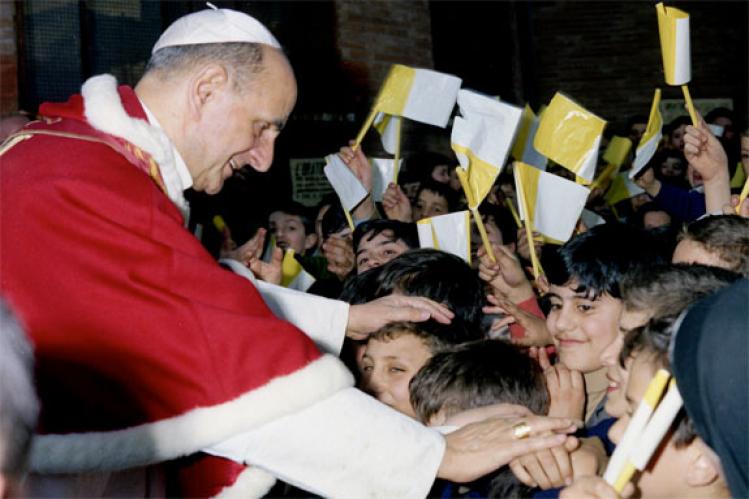
March 7, 1965, came to be known as Bloody Sunday in the civil-rights movement, as peaceful protesters in Selma, Alabama, were assaulted by police wielding clubs and tear gas. The same day, Pope Paul VI entered All Saints Church in the suburbs of Rome and said Mass in Italian. It was the first vernacular Mass celebrated by the pope in modern times. Pope Francis will mark that anniversary about two weeks from now.
At first glance, these two events seem to have nothing to do with each other. After all, what difference can it possibly make to the cause of racial justice that Catholics are now permitted to celebrate Mass in the vernacular? It was a big deal for the Catholic faithful and clergy at the time, to be sure. But we’ve gotten used to it. For many, then as now, its value seems to rest in nave and sanctuary and not in the streets. I believe a link exists, and is worth considering. The introduction of the vernacular was not only undertaken for the good of the people already within the fold. It was also intended as a pledge and a promise for the Catholic Church to reach out beyond itself, for the sake of its mission. Pope Paul VI said it clearly from the balcony of St. Peter’s on that day: “The church has made this sacrifice of an age-old tradition [Latin] and above all in unity of language among diverse peoples to bow to a higher universality, an outreach to all peoples.”
Use of vernacular languages in the liturgy is an outstanding sign of Vatican II’s famous “opening to the world”—the world not as a great shopping mall of delights, but as angry and wounded, a despairing world in need of the gospel of compassion and justice and joy. The world of the poor. The world of Selma. In the words of Gaudium et spes, the Pastoral Constitution on the Church in the Modern World: “The joys and hopes, the griefs and the anxieties of the men [and women] of our time, especially those who are poor or in any way afflicted, are the joys and hopes, the griefs and anxieties of the followers of Christ.” Too many Catholics tend to think of the document on the Liturgy, Sacrosanctum concilium, as one end of the spectrum, and Gaudium et spes as the other. They belong together.
Paul VI’s words surely resonated with missionary bishops and others on “the periphery”—the developing world, churches oppressed under communism, Eastern Rite Catholics—who took part in the debate at the council. Although they remained respectful of Latin, they were not convinced by the claim that Latin is the great “sign and psychological agent” of the church’s unity. Bishop Franz Simons of Indore, India, for example, pointed out with merciless clarity that Latin, which was supposed to unite, had actually become a source of division: between clergy and laity, between East and West, and between the church and the world. Patriarch Maximos IV Saigh, leader of the Melkite delegation, famously refused to speak Latin at the council, preferring to use French as a reminder to the Latin Rite bishops that Latin is not the language of all Catholics. It’s not as though these bishops didn’t prize unity. They did. But they wisely looked to the Holy Spirit to provide it through many tongues, as the Spirit provided it on the day of Pentecost.
Arguments explaining the shift to the vernacular have so often been pragmatic that I fear we’ve overlooked the symbolic importance of what we do when we celebrate the liturgy in our own language. The result is a flat, ho-hum account of what the church is up to. Latin is mystical and interesting. The vernacular? Just words. Besides, if we evaluate the shift to the vernacular only in terms of practicality, the story is over. The goal of a fully vernacular liturgy has been achieved. Taking the vernacular for granted has left the church vulnerable to efforts to “re-Latinize” our vernacular translations.
We have vernacular liturgy but we may have missed what is most essential about it. Use of vernacular in the liturgy is a matter of mission and evangelization. When Paul VI celebrated the liturgy in Italian, it was a pledge to future generations that the church and her liturgy would lean toward outreach and mission. This is where the growth continues. The Mass Pope Francis will commemorate was the end point of a long journey; but, more important, it is also a starting point.
A liturgy “open to the world” is not a liturgy without structure or boundaries, but it is one that can extend hospitality to seekers, remove barriers to ecumenism, and speak in a language contemporary people can claim, own, and understand. It is a liturgy that takes place in a dynamic relationship with the world around us, for the vernacular languages are not “dead” languages; they continue to change as the communities that speak them change. The vernacular liturgy is a sign that our discipleship must unfold in the world. It is a promise by the church to be there for the people who actually need us.
Please email comments to [email protected] and join the conversation on our Facebook page.
Previous Story
Northward Bound
Next Story
Our new issue is live


